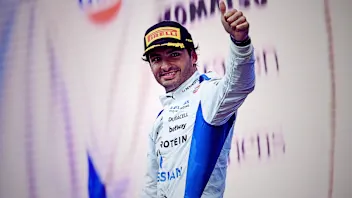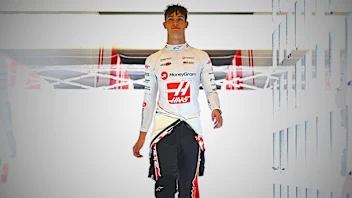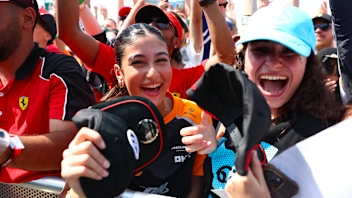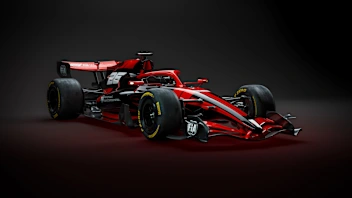Hockenheim first hosted a world championship race in 1970, but even before that it had earned a reputation as a home for the brave, a circuit for the daring. It was a flat-out blast through the forest; a track where, as two-time Hockenheim winner Gerhard Berger put it, "your foot keeps on wanting to come off the accelerator".
Over the decades small modifications were made to the breath-taking blend of long straights and sweeping bends, but the circuit retained its fundamental character up until the turn of the century, when radical revisions were implemented.
The old circuit, while unique and fondly remembered, was not without limitations: its layout was fast and narrow - with limited run-off - and not particularly conducive to overtaking. At 6.8 kilometres, it was felt to be too long - particularly as a small spectator capacity meant it was prohibitively expensive to run. The circuit in general needed to modernise. Bosses were therefore at a crossroads, striving to update the track while also retaining the characteristics which had come to define it as a driver's favourite, and a test not just of machine and skill but also character.
"The Hockenheimring has always been a magnet of attraction for the area," explains the circuit's CEO Georg Seiler. "Having recognised this factor, and the competition of new, modern race tracks - in Germany and abroad - the decision was made to finance a complete modernisation in 2002 and '03.
"The main goals were: to shorten the track from 6.8km to 4.5km, now standard for modern F1 tracks; to improve conditions for overtaking; and to keep the circuit's main characteristics."
There were two prerequisites needed before any construction could be considered - the consent of the citizens of the city of Hockenheim, and the financial support of the state of Baden-Württemberg.
"Both greatly benefited financially from [hosting F1]," Seiler says. Eighty per cent of the populace lent their support, and the decision was therefore made to jointly finance the new enterprise.
The task itself fell to renowned circuit designer Hermann Tilke, who was approached, says Seiler, "for three reasons: experience, expertise and vision."
That vision, however, would change over time as various considerations and restrictions came into play.
"The old Hockenheimring was a fast-lane track with long straights," Tilke explains. "There was something very special about it, about how rare its layout was, so we wanted therefore to keep as much as possible of the old track.
"The original idea was just to broaden the existing track according to current safety regulations, and to keep the track to its original length. At that time the restrictions and possibilities the site offered were not clear however and the idea eventually proved unfeasible.
"Firstly, there was a doctrine to save forests, and to even merge the enclosed section of trees with the adjacent forest, so chopping down trees had to be kept to an absolute minimum. That produced a second constraint: we had to use as little area as possible for the new track. Then of course we had to factor in financial resources and a tight timescale.
"The task became to design something new, on the existing site, and make it more interesting and accessible for visitors, all without impacting upon the woodland. Today's track layout is the result of that intense idea exchange and development process, conducted alongside the Hockenheim management."
The revamp was also the product of extensive simulation work, and consultation with the men who would actually race on the new circuit. Michael Schumacher, who at the time was in the early stages of his record-breaking run of five straight world championship crowns with Ferrari, was among those to have an input.
"We have an in-house simulation programme and therefore conducted virtual tests of our new design, which at that point existed only on paper and as CAD [computer-aided design] files," Tilke explains. "There was also an exchange of views and ideas with drivers including Schumacher, because he was chairman of the Grand Prix Drivers' Association at the time. We mainly discussed safety concerns, but they also had a few inputs into the design phase."
Finally, a plan was settled - the famous ‘stadium' section of the circuit would be retained, with the right-hand Nordkurve still the first corner. Rather than running from there down to the Clark and then Ost chicanes, however, the track would turn right once more and cut back on itself via a long straight, Parabolika, which would run down to the Spitzkehre hairpin, situated just before the Senna chicane of the old layout.
Another loop would be added to break up the back straight, before the track returned to the old atmospheric stadium section and the end of a 4.574km lap.
"Keeping the motodrom and the start-finish line was one of the main issues of our design and led to the implementation and design of the new Parabolika, as a substitute for the ‘missing' straights," Tilke adds. "The new shape followed the obligation of sparing the existing woodland and reducing the area used, while creating a fantastic track popular with drivers and also visitors.
"One of our tasks was actually to increase the number of visitors, so the construction of new grandstands was very important too. With the new layout, we built a new grandstand where one can oversee 90 percent of the new section, with fantastic views of the Parabolika, hairpin and chicane. In comparison to the original design, there is an increase in capacity of 37,000 now."
It was at this stage that complications racketed up a notch. Hockenheim was still the regular host of the German Grand Prix - the Nurburgring hosted the European race - meaning that just 12 months were available for the radical revisions to be completed.
"Schedules for building and construction were very tight - the race date was already fixed, so there was a deadline come what may," Tilke admits. "The last F1 race on the old track took place on 29 July 2001. In 2002, we were on the new circuit already.
"Of course there were some unexpected occurrences, as happen in every construction project. We had some very bad soil conditions in some areas, and we ended up having to replace sections. The weather was also bad at times, which time-wise was a problem for us. Regardless, the schedule could not change."
Nor did it. On 28 July 2002 the new Hockenheim hosted its first Grand Prix, with Michael Schumacher triumphing for Ferrari - his first victory at Hockenheim. "I like this new circuit and in my opinion it's a great success," Schumacher enthused during the weekend. "Of course it requires a lot more aerodynamic downforce than the old Hockenheim and that means the Motodrom section has become more fun to drive. I have been dreaming of this result for a long time - it seemed that Hockenheim was not supposed to be mine. It means a lot to me."
The seven-time world champion was not the only man to praise the changes. Seiler believes they helped usher in a new era for the track, even if as CEO he admits to a certain romanticism about the old venue.
"It is a real asset for fans, particularly areas like the Mercedes tribune, where they have the opportunity to see a huge area of the track from the Parabolika to the hairpin," he reflects.
"Old parts of the track, running through the forest, were an outstanding attribute of the old Hockenheimring, and are sometimes dearly missed - but the changes achieved everything we wanted, and gave us a modern track worthy of hosting Formula One racing."
Next Up
Related Articles
 ExclusiveWhy Sainz feels ‘vindicated’ after his first Williams year
ExclusiveWhy Sainz feels ‘vindicated’ after his first Williams year ExclusiveHow Bearman went from super-sub to star rookie in 2025
ExclusiveHow Bearman went from super-sub to star rookie in 2025 Formula 1’s record-breaking 2025 season in numbers
Formula 1’s record-breaking 2025 season in numbers 10 ways to get your Formula 1 fix during the winter break
10 ways to get your Formula 1 fix during the winter break EXPLAINED: The key terms for F1’s new-for-2026 rules
EXPLAINED: The key terms for F1’s new-for-2026 rules GALLERY: Check out renders of the innovative 2026 car
GALLERY: Check out renders of the innovative 2026 car